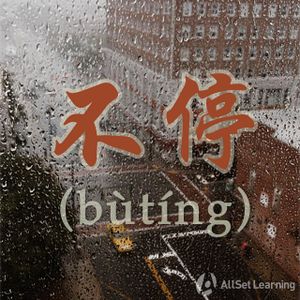Difference between revisions of "Comparing "buduan" and "buting""
| Line 15: | Line 15: | ||
===Examples=== | ===Examples=== | ||
| − | + | ||
| + | <div class="liju"> | ||
| + | *客户 <em>不断地</em> 改变 主意,怎么 办? | ||
| + | *过去 的 两 年 里,我们 <em>不断地</em> 在 努力,也 <em>不断地</em> 在 进步。 | ||
| + | *他们 之间 的 矛盾 一直 <em>不断</em>,关系 <em>不断</em> 恶化。 | ||
| + | </div> | ||
==不停== | ==不停== | ||
| Line 25: | Line 30: | ||
Subject + 不停 + 地 + Verb | Subject + 不停 + 地 + Verb | ||
| + | </div> | ||
| + | |||
| + | ===Examples=== | ||
| + | |||
| + | <div class="liju"> | ||
| + | *我今天很困,<em>不停地</em>打哈欠。 | ||
| + | *感冒了,喉咙痛,还<em>不停地</em>留鼻水。 | ||
| + | *吃饭的时候他一句话也不说,<em>不停地</em>吃。 | ||
</div> | </div> | ||
| Line 36: | Line 49: | ||
===Examples=== | ===Examples=== | ||
| − | + | ||
| + | <div class="liju"> | ||
| + | *孩子 <strong>哭</strong> <em>个不停</em>,是 不 是 发烧 了? | ||
| + | *今天 电话 <strong>哭</strong><em>个不停</em>,烦 死 了。 | ||
| + | *一天到晚 老婆 <strong>哭</strong> <em>个不停</em>,你 受 得 了 吗? | ||
| + | </div> | ||
==Sources and Further Reading== | ==Sources and Further Reading== | ||
[[Category:grammar comparison]] | [[Category:grammar comparison]] | ||
| − | {{Basic Grammar|不断|B2|不断 vs 不停| | + | {{Basic Grammar|不断|B2|不断 vs 不停|她 <em>不断</em> 地 找 我,每次 都 说 个 <em>不停</em>|grammar point|ASGIKHUH}} |
{{Rel char|不停}} | {{Rel char|不停}} | ||
{{Similar|"All along" with "yizhi"}} | {{Similar|"All along" with "yizhi"}} | ||
Revision as of 03:28, 19 July 2013
| This article is a stub. Editors can help the Chinese Grammar Wiki by expanding it. |
-
Level
-
Similar to
-
Used for
-
Keywords
If something keeps happening and won't stop happening, we say that it is "continuous" or "incessant". In Chinese, the words are "不断" (bùduàn) and "不停" (bùtíng). Instead of being adjectives, these two words are adverbs to modify what is being done. However, they are used in different ways and different places, so this article will help you distinguish when and where to use them.
不断
"不断" is usually placed before the verb it modifies, and it often requires the particle "地" to show that it is an adverb.
Subject + 不断 + 地 + Verb
Examples
- 客户 不断地 改变 主意,怎么 办?
- 过去 的 两 年 里,我们 不断地 在 努力,也 不断地 在 进步。
- 他们 之间 的 矛盾 一直 不断,关系 不断 恶化。
不停
"不停" is a little more versatile and can be placed both before the verb as an adverb, or after the verb as something that is somewhat like a complement. Either way, it means the same thing.
Subject + 不停 + 地 + Verb
Examples
- 我今天很困,不停地打哈欠。
- 感冒了,喉咙痛,还不停地留鼻水。
- 吃饭的时候他一句话也不说,不停地吃。
When "不停" comes after the verb, it behaves somewhat strangely and takes "个" before it in order to become grammatical, like so:
Subject + Verb + 个 + 不停
Examples
- 孩子 哭 个不停,是 不 是 发烧 了?
- 今天 电话 哭个不停,烦 死 了。
- 一天到晚 老婆 哭 个不停,你 受 得 了 吗?



